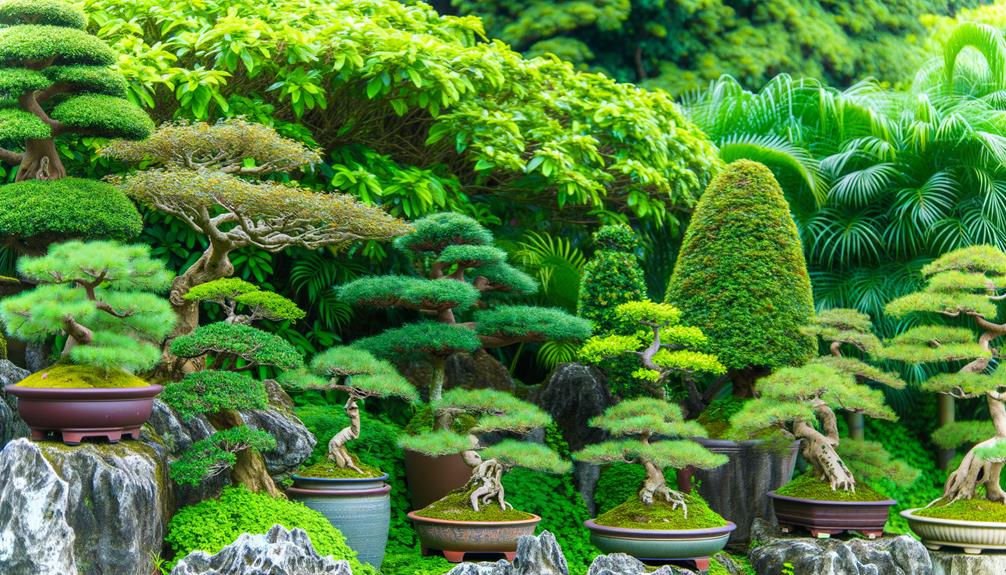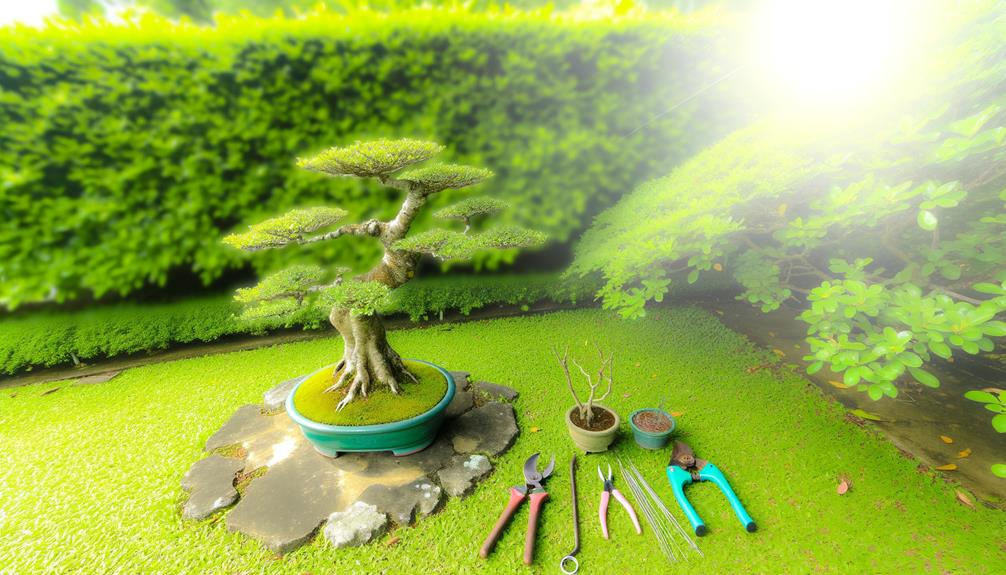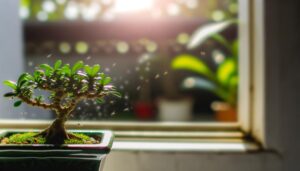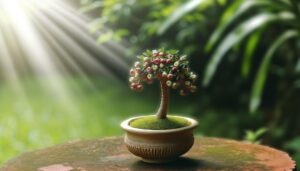Planting Bonsai Trees Outside: A Beginner’s Guide
Planting a bonsai tree outside is feasible and advantageous if proper species selection aligns with local climatic conditions. Choose hardy species like junipers, pines, and maples for outdoor cultivation.
Guarantee the selected location provides 4-6 hours of direct sunlight with adequate dappled shade. Utilize a well-draining soil mix of akadama, pumice, and lava rock to prevent root rot.
Implement precise irrigation practices and consider microclimatic factors to optimize photosynthesis. Protect from extreme weather using windbreaks and rain covers.
Regular pruning and pest management are essential. Proper expertise can further guide successful outdoor bonsai cultivation.

Key Takeaways
- Yes, many bonsai species like junipers, pines, and maples are suitable for outdoor cultivation.
- Ensure your bonsai receives 4-6 hours of direct sunlight and dappled shade daily.
- Use well-draining soil mixes, such as a combination of akadama, pumice, and lava rock.
- Protect bonsai from extreme weather conditions with windbreaks and rain covers.
- Adjust watering frequency based on the specific needs of the bonsai species and local climate.
Types of Outdoor Bonsai

Outdoor bonsai trees, such as junipers, pines, and maples, exhibit unique physiological adaptations that enable them to thrive in varying climatic conditions.
Junipers (Juniperus spp.) possess scale-like foliage and a waxy cuticle, reducing transpiration and enhancing drought resistance.
Pines (Pinus spp.) exhibit needle-like leaves and extensive root systems, facilitating efficient water and nutrient uptake.
Maples (Acer spp.) are characterized by broad, palmate leaves with a high photosynthetic capacity, supporting robust growth and seasonal color changes.
Each species' xylem and phloem structures are optimized for efficient sap transport, ensuring resilience against environmental stressors.
Understanding these botanical traits is imperative for selecting appropriate bonsai species, thereby ensuring successful cultivation and aesthetic refinement in outdoor settings.
Climate Considerations
Selecting the appropriate bonsai species is only the initial step; understanding the specific climatic requirements is paramount for guaranteeing their long-term viability and health in outdoor settings. Bonsai trees, like all plants, have distinct temperature, humidity, and light needs.
To thrive, consider the following factors:
- Temperature Tolerance: Identify the minimum and maximum temperature ranges your bonsai species can withstand. Some species require cold dormancy periods, while others are sensitive to frost.
- Humidity Levels: Ensure the local humidity aligns with the bonsai's natural habitat. Dry climates might necessitate additional humidity control measures.
- Light Exposure: Evaluate the intensity and duration of sunlight the bonsai requires. Insufficient light can hinder photosynthesis, while excessive light can cause leaf burn.
These climate considerations are essential for outdoor bonsai cultivation.
Choosing the Right Location

Selecting the best location for planting an outdoor bonsai tree necessitates a careful evaluation of its specific requirements for sunlight and shade balance, soil composition, and drainage capabilities.
Ensuring adequate protection from environmental stressors such as wind and extreme temperatures is equally essential to maintain the tree's health and growth.
Sunlight and Shade Balance
Achieving the finest balance between sunlight and shade is crucial for the health and development of a bonsai tree when planted outdoors. Optimum photosynthesis and growth are dependent on this equilibrium.
To accomplish this, consider these factors:
- Photoperiod: Guarantee the bonsai receives at least 4-6 hours of direct sunlight daily, depending on the species' specific photosynthetic needs.
- Shade Tolerance: Select a location that provides dappled shade during peak sunlight hours to prevent leaf scorch and dehydration.
- Microclimate: Evaluate the microclimatic conditions, such as ambient temperature and wind exposure, which can impact transpiration rates and overall vigor.
Balancing these elements ensures the bonsai's physiological processes are regulated, promoting vigorous growth and longevity.
Soil and Drainage Needs
To maximize growth and health of an outdoor bonsai tree, it is vital to select a location with well-draining soil that maintains sufficient moisture without becoming waterlogged. The soil composition should ideally be a balanced mix of inorganic and organic components, such as akadama, pumice, and a small proportion of composted bark to enhance nutrient availability. Proper drainage is essential; hence, guarantee the substrate has a granular structure to facilitate aeration and prevent root rot.
Conduct a percolation test by saturating soil and observing drainage rate; ideal conditions allow water to percolate within 2-3 hours. Elevate planting sites slightly or use mounded beds to improve runoff in areas prone to heavy rainfall, ensuring that the root zone remains oxygenated and healthy.
Protection From Elements
Ensuring the best spot for an outdoor bonsai tree involves lessening exposure to extreme elements such as intense sunlight, strong winds, and heavy precipitation. Ideal placement is vital to maintain the microclimate conducive to bonsai health.
Consider the following:
- Sunlight: Position the tree where it receives dappled sunlight, avoiding direct afternoon sun to prevent leaf scorch and dehydration.
- Wind Protection: Utilize natural windbreaks or barriers, like hedges or fences, to shield the bonsai from strong gusts that can cause desiccation or physical damage.
- Precipitation Control: Guarantee the site has proper drainage and, if needed, use rain covers or shelters during heavy rain to prevent root rot and waterlogging.
Soil Requirements
Proper soil composition is crucial for the successful outdoor cultivation of a bonsai tree, necessitating a well-balanced mix of organic and inorganic components to secure sufficient drainage, aeration, and nutrient availability. The soil matrix should typically consist of akadama, pumice, and lava rock in a ratio of 2:1:1. Akadama provides water retention and nutrient absorption, pumice guarantees aeration, and lava rock promotes effective drainage. A balanced soil mix prevents root rot and supports prime growth.
| Component | Function | Ratio |
|---|---|---|
| Akadama | Water retention | 2 parts |
| Pumice | Aeration | 1 part |
| Lava Rock | Drainage | 1 part |
Utilizing this soil matrix establishes a conducive environment for root health and overall well-being.
Watering Needs

A bonsai tree's watering schedule must account for factors such as species-specific needs, climatic conditions, and soil composition to achieve ideal hydration without causing waterlogging. Best irrigation practices necessitate understanding transpiration rates, root zone aeration, and soil moisture retention.
To achieve precise hydration, consider the following:
- Species-Specific Hydration: Different bonsai species, such as Juniperus or Ficus, have unique water requirements.
- Climatic Considerations: In arid regions, increased watering frequency is essential, whereas in humid climates, reduced watering suffices.
- Soil Composition: Use well-draining substrates like akadama or pumice to mitigate root rot risks.
Light Conditions
Optimal light conditions for bonsai trees necessitate a delicate balance of photoperiod, light intensity, and spectral quality to support photosynthesis and overall plant health. Bonsai trees generally thrive under full sun, needing a minimum of 5-6 hours of direct sunlight per day.
The intensity of the light should mimic natural sunlight, ideally around 2,000 foot-candles. Spectral quality is essential; make sure exposure to a full spectrum of light, particularly the blue and red wavelengths that optimize chlorophyll absorption and growth.
Position your bonsai to avoid prolonged shade, which can hinder photosynthetic efficiency and lead to etiolation. Additionally, monitor the solar angle throughout the year to adjust placement, guaranteeing consistent light availability.
Seasonal Care

Seasonal care for outdoor bonsai trees involves implementing frost protection measures. This can be done by using horticultural fleece or relocating the bonsai to a sheltered environment during sub-zero temperatures.
Watering frequency must be adjusted according to seasonal evapotranspiration rates to maintain optimal soil moisture levels. This meticulous approach helps ensure the health of the bonsai tree.
Pruning techniques should be seasonally calibrated. Structural pruning is typically done during dormancy to shape the bonsai tree, while maintenance pruning is conducted during the growing season to promote desired growth patterns.
Frost Protection Measures
To mitigate frost damage during the winter months, implement a multifaceted approach that includes thermal insulation, strategic placement, and the use of antifreeze products.
- Thermal Insulation: Utilize horticultural fleece or burlap to wrap the bonsai, providing a thermal barrier against subzero temperatures.
- Strategic Placement: Relocate the bonsai to a sheltered location, such as near a wall or under an overhang, to reduce exposure to cold winds.
- Antifreeze Products: Apply anti-desiccants to the foliage, which form a protective layer, minimizing water loss and frost damage.
Adhering to these guidelines guarantees that the bonsai maintains cellular integrity and metabolic function, essential for surviving harsh winter conditions. Each measure contributes synergistically to the overall resilience of the bonsai against frost.
Watering Frequency Adjustment
Adjusting the watering frequency for outdoor bonsai trees requires a precise understanding of the plant's evapotranspiration rate, soil moisture retention capacity, and seasonal climatic variations. During the summer, high temperatures and increased solar radiation elevate evapotranspiration rates, necessitating more frequent irrigation to prevent hydric stress.
Conversely, in winter, reduced sunlight and lower temperatures result in decreased water uptake, requiring less frequent watering to avoid root rot. Utilize a soil moisture meter to monitor substrate hydration levels accurately. Additionally, consider the specific bonsai species' water requirements, as some, like Juniperus, prefer drier conditions, whereas species such as Acer palmatum demand consistent moisture.
Regularly adjust watering schedules based on real-time climatic data and phenological observations to maintain optimal plant health.
Pruning Seasonal Techniques
Pruning techniques for outdoor bonsai trees must be carefully timed and executed to align with the plant's dormancy cycles and growth phases, ensuring structural integrity and best health. Seasonal pruning involves understanding phenological stages and implementing precise interventions:
- Spring Pruning: Conduct structural and maintenance pruning during early spring before bud break. Focus on removing deadwood and crossing branches to promote vigorous growth.
- Summer Pruning: Pinch back new growth to maintain shape and size. Execute leaf pruning (defoliation) to reduce leaf size and enhance ramification.
- Autumn Pruning: Perform light structural pruning post-leaf fall to prepare the tree for dormancy. Avoid heavy pruning to prevent winter stress and dieback.
Proper timing and technique are essential for optimizing the health and aesthetics of outdoor bonsai.
Protecting From Pests
Implementing integrated pest management (IPM) techniques is crucial for safeguarding outdoor bonsai trees from various pests. Begin by conducting regular inspections to identify early signs of infestation, such as discolored foliage or abnormal growth patterns.
Utilize biological controls, including beneficial insects like ladybugs and predatory mites, to naturally suppress pest populations. Employ mechanical interventions, such as handpicking larger pests or using fine mesh netting to exclude insects.
Chemical controls should be a last resort; choose targeted, systemic insecticides with minimal non-target impact. Additionally, maintain prime tree health through proper watering, fertilization, and adequate sunlight to bolster natural defenses.
Regularly clean and sanitize tools to prevent pathogen transmission, thereby ensuring your bonsai remains robust and pest-free.
Pruning and Shaping

Maintaining structural integrity and aesthetic appeal through precise techniques, such as apical dominance control and strategic branch selection, is fundamental when pruning and shaping outdoor bonsai trees. Adhering to rigorous horticultural principles promotes growth and form.
- Apical Dominance Control: Prune the apex to redirect energy to lower branches, promoting an even growth distribution.
- Strategic Branch Selection: Remove any crossing, crowded, or downward-growing branches to enhance airflow and light penetration.
- Wiring Techniques: Employ copper or aluminum wires to guide branch orientation, ensuring they grow in desired directions while avoiding damage to the cambium layer.
These meticulous practices contribute to both the health and visual harmony of outdoor bonsai specimens, fostering a balance between natural growth patterns and artistic design.
Common Mistakes
When planting a bonsai tree outside, horticulturists often encounter pitfalls such as incorrect soil composition and excessive irrigation. Utilizing suboptimal soil that lacks proper aeration and drainage properties can impede root development and overall plant health.
Additionally, overwatering can lead to root rot and fungal infections, necessitating a well-calibrated irrigation schedule tailored to the specific species and environmental conditions.
Wrong Soil Choice
Selecting inappropriate soil for your bonsai tree can lead to poor drainage, insufficient nutrient supply, and subpar root aeration, ultimately compromising the tree's health and growth.
The following are critical considerations when choosing soil for outdoor bonsai:
- Granule Size: Make sure the soil mix includes various granule sizes to promote adequate drainage and prevent root rot, enhancing oxygen availability.
- Nutrient Content: Utilize a soil blend with balanced organic and inorganic components to provide essential macro and micronutrients, facilitating robust growth and well-being.
- Water Retention: Opt for a substrate that retains moisture without becoming waterlogged, employing materials like Akadama, pumice, and lava rock to achieve optimal hydration levels.
Adhering to these guidelines will greatly enhance the overall health and growth conditions for your outdoor bonsai.
Overwatering Risk
Excessive watering, often a result of misunderstanding the tree's hydration needs, can lead to root rot, fungal infections, and ultimately the decline of your outdoor bonsai's health.
It is essential to recognize that bonsai trees require a delicate balance of moisture. Overwatering causes the soil to become waterlogged, depriving roots of necessary oxygen and fostering pathogenic fungi. Implementing a well-draining substrate, such as a mix of akadama, pumice, and lava rock, can mitigate this risk.
Additionally, employing a moisture meter to monitor soil hydration levels can provide accurate data, preventing the excessive application of water. Adopting these practices ensures the maintenance of optimal root health and promotes the overall vitality of the bonsai tree in an outdoor environment.
Expert Tips

To maximize growth and longevity of your outdoor bonsai tree, it is important to carefully monitor soil composition, moisture levels, and sunlight exposure.
Implementing these expert tips will optimize your bonsai's health:
- Soil Composition: Utilize a well-draining soil mix, typically composed of akadama, pumice, and lava rock, to maintain aeration and prevent root rot.
- Moisture Levels: Employ a hygrometer to measure soil moisture, ensuring the substrate remains consistently damp but not waterlogged.
- Sunlight Exposure: Position the bonsai in a location with partial to full sunlight, adjusting based on species-specific photoperiod requirements and seasonal variations.
Conclusion
To sum up, cultivating an outdoor bonsai tree requires a detailed understanding of various factors such as species selection, climatic conditions, best location, soil composition, irrigation needs, pest control, and proper pruning methods. Following these guidelines guarantees the flourishing of the bonsai, turning it into a living proof of horticultural accuracy, much like a well-orchestrated symphony.
Steering clear of typical mistakes and following expert advice additionally enhances the successful cultivation of this miniature tree.






